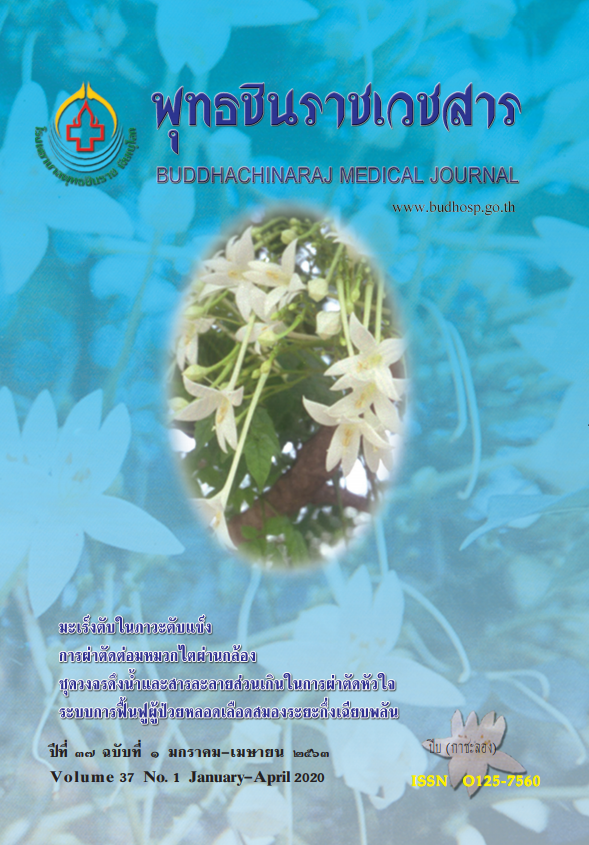ผลของระบบบริการฟื้นฟูในผู้ป่วยหลอดเลือดสมองระยะกึ่งเฉียบพลัน ระหว่างการดูแลแบบผู้ป่วยใน ผู้ป่วยนอก และที่บ้าน
ผลของระบบบริการฟื้นฟูในผู้ป่วยหลอดเลือดสมองระยะกึ่งเฉียบพลัน
คำสำคัญ:
ผู้ป่วยหลอดเลือดสมองระยะกึ่งเฉียบพลัน, ระบบบริการฟื้นฟู, การดูแลระยะกลางบทคัดย่อ
บริการฟื้นฟูสภาพเป็นการเพิ่มคุณภาพชีวิตให้ผู้ป่วย การวิจัยแบบกึ่งทดลองนี้มีวัตถุประสงค์เพื่อเปรียบเทียบผลของระบบบริการ ฟื้นฟูสภาพระยะกลางแบบผู้ป่วยใน ผู้ป่วยนอก และที่บ้าน โดยประเมินจากคะแนนบาร์เธล (BI) ที่เปลี่ยนแปลง ศึกษาในผู้ป่วย หลอดเลือดสมองระยะกึ่งเฉียบพลันที่มารับบริการที่กลุ่มงานเวชกรรมฟื้นฟู โรงพยาบาลศรีสังวรสุโขทัยระหว่างเดือนมกราคมถึงเดือนสิงหาคม พ.ศ. 2562 ซึ่งมี 27 คน โดยแบ่งผู้ป่วยเป็น 3 กลุ่มตามรูปแบบบริการฟื้นฟู นำเสนอข้อมูลเป็นค่าความถี่ ค่าร้อยละ ค่าเฉลี่ย ค่าเบี่ยงเบนมาตรฐาน และค่ามัธยฐาน (Q1, Q3) เปรียบเทียบคะแนน BI ก่อนและหลังการฟื้นฟูในแต่ละกลุ่มด้วยการ ทดสอบ Wilcoxon signed rank กำหนดนัยสำคัญทางสถิติที่ระดับ 0.05 ผลการศึกษาพบว่าผู้ป่วยที่ได้รับการฟื้นฟูทั้ง 3 รูปแบบ บริการหลังฟื้นฟูครบ 3 เดือนมีคะแนน BI เพิ่มขึ้นอย่างมีนัยสำคัญทางสถิติ พบภาวะแทรกซ้อนเฉพาะในกลุ่มที่ได้รับการฟื้นฟูแบบ ที่บ้าน สรุปได้ว่าบริการฟื้นฟูสภาพระยะกลางทั้ง 3 รูปแบบทำให้ผู้ป่วยสามารถทำกิจวัตรประจำวันได้เพิ่มขึ้น แสดงถึงบริการฟื้นฟู ทุกรูปแบบนำไปสู่ผลลัพธ์ที่ดี
เอกสารอ้างอิง
2. Committee of Sub-acute Rehabilitation Care Project. The Thai Rehabilitation Medicine Association. Development of sub-acute rehabilitation program and lesson learned from the Ministry of Public Health [Internet]. 2016 [cited 2019 January 2]. Available from: URL:http://rehabmed.or.th/files/book.pdf
3. The Ministry of Public Health. Intermediate Care Service Plan [Internet]. 2017 [cited 2019 January 20]. Available from: URL: http://www.snmri.go.th/snmri/download/train/pm/Intermediate_1.pdf
4. Wade DT, Collin C. The Barthel ADL Index:A standard measure of physical disability?. Int Disabil Stud 1988;10(2):64-7.
5. Rehabilitation Medicine Department, Srisangwornsukhothai Hospital. Annual Report 2018. The rate of stroke patients undergoing rehabilitation. Sukhothai:Rehabilitation Medicine Department,Srisangwornsukhothai Hospital; 2018.
6. Ngamjarus C, Chongsuvivatwong V. n4Studies version 1.4.1 [computer software]. Sample size and power calculations for android. The Royal Golden Jubilee Ph.D.Program-The Thailand Research Fund, Prince of Songkla University. Available from:
URL: http://play.google.com/store/apps/details?id=com.chetta.n4Studies&hl=en_US
7. Khiaocharoen O, Pannarunothai S, Riewpaiboon W, Zungsontiporn C. Rehabilitation service development for sub-acute and non-acute patients under the Universal Coverage Scheme in Thailand. J Health Sci 2015;24(3):493-509.
8. Dajpratham P, Meenaphant R, Junthon P, Pianmanakij S, Jantharakasamjit S, Yuwan A. The inter-rater reliability of Barthel Index (Thai version) in stroke patients. J Thai Rehabil Med 2006;16:(1)1-9.
9. Paolucci S, Antonucci G, Grasso MG, Morelli D, Troisi E, Coiro P, et al. Early versus delayed inpatient stroke rehabilitation:A matched comparison conducted in Italy. Arch Phys Med Rehabil 2000;81(6):695-700.
10. Musicco M, Emberti L, Nappi G, Caltagirone C. Italian Multicenter Study on outcomes of rehabilitation of neurological patients. Early and long-term outcome of rehabilitation in stroke patients: The role of patient characteristics, time of initiation, and duration of interventions. Arch Phys Med Rehabil 2003;84(4):551-8.
11. Wang H, Camicia M, DiVita M, Mix J, Niewczyk P. Early inpatient rehabilitation admission and stroke patient outcomes. Am J Phys Med Rehabil 2015;94(2):85-96.
12. Kwansanit T. Outcomes of sub-acute rehabilitation program in stroke patients, Suratthani Hospital. Region 11 Med J 2017;31(4):723-32.
13. Pattanasuwanna P. Outcomes of intermediate phase post-stroke inpatient rehabilitation in community hospital. Asean J Rehabil Med 2019;29(1):8-13.
14. Suksathien R, Sukpongthai T. Predictor of long-term functional outcomes in acute stroke patients. J Thai Rehabil Med (ASEAN J Rehabil Med, since 2019) 2017;27(3):96-100.






